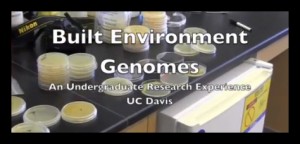 I haven’t talked a lot about this here, but in addition to the microBEnet website and conference organization we have been running a couple of undergraduate research projects related to the microbiology of the built environment.
I haven’t talked a lot about this here, but in addition to the microBEnet website and conference organization we have been running a couple of undergraduate research projects related to the microbiology of the built environment.
The first was a project started in January where a team of undergraduates isolated organisms from the built environment and sequenced several bacterial genomes in order to facilitate ongoing metagenomic studies. Check out the blog for that project here.
Recently we’ve started a new project looking at the biogeography and succession of microbial communities in aquariums.
Part of the genome sequencing project was the creation of a short (4 mins) documentary video describing the project from start to finish. I’ve finally finished editing it so here it is:
Transcript of Video:
People spend over 90% of their time indoors, yet our understanding of the microbiology of the built environment is surprisingly shallow.
To address this, the Alfred P. Sloan Foundation has funded a multi-year program focused on fundamental research in this area.
This video describes an undergraduate research project undertaken with funding from the Sloan Foundation. The goals of this project were two-fold.
Firstly, to produce a number of sequenced reference genomes from the built environment, in order to facilitate ongoing metagenomic studies. Secondly, to provide a unique research experience for undergrads while demonstrating the feasibility of microbial genome sequencing at this educational level.
To accomplish this we isolated, cultured, and identified bacteria from a variety of built environments. We then selected candidates for sequencing, prepared DNA libraries and sequenced the genomes. This was followed by genome assembly, annotation, and publication of the results.
To begin, we collected samples from numerous places in the built environment including homes, offices, and vehicles.
Bacteria were cultured in rich media, and grown at a variety of temperatures. Once single colonies were established by dilution streaking, overnight cultures were grown.
This was followed by isolation of DNA, then amplification of the 16S ribosomal RNA gene in order to establish the identity of the bacteria. You can think of this gene sequence as a “barcode” for identifying organisms.
Once a large number of bacteria had been isolated, we selected candidates for sequencing. Our primary considerations were that they had never been sequenced and that they might play a role in the microbial ecology of the built environment.
This was followed by paired-end Illumina library construction and sequencing here at UC Davis.
Once the sequencing was complete, the students had to make the difficult shift from being lab biologists to bioinformaticians.
They began with genome assembly using the a5 assembly pipeline and an assessment of the quality of the assembly. This was followed by annotation of the genomes using RAST, which is a program that predicts the presence and function of genes in the sequence.
From this point the students branched out. They created phylogenetic trees to see where their bacteria fit in, they performed comparative genomics to other close relatives that had been sequenced, and they dug deeper into the biochemistry as predicted by the annotation.
Results and data are currently being condensed into a series of genome papers, authored by the students themselves.
Along the way these students got to experience all the ups and downs of science; contamination, failure of reagents, broken machines, inexplicable results, and fear of the command line.
At the end of the day however, they walked away with a unique research experience and a feeling that they had really contributed to the body of scientific knowledge.
And we had plenty of fun along the way…